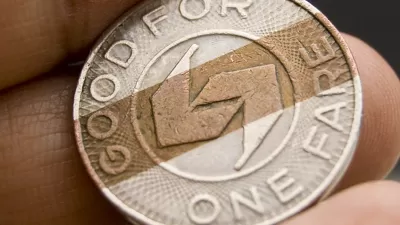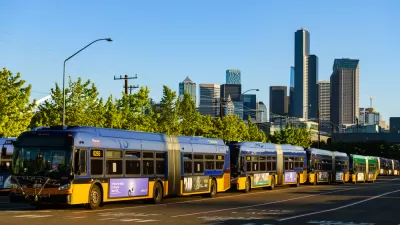A couple of weeks ago, I was on a bus in Chicago and noticed something that I had not noticed before- that how you paid to get on the bus affected how long you took to get on the bus. People who flashed monthly passes boarded in a few seconds. People who put in dollar bills got on a lot more slowly, as they fumbled for the right number of bills. People who had to pay change took longer still. So to speed buses’ on-time performance (pun intended) transit agencies should encourage the former and discourage the latter.
A couple of weeks ago, I was on a bus in Chicago and noticed
something that I had not noticed before- that how you paid to get on the bus
affected how long you took to get on the bus.
People who flashed monthly passes boarded in a few seconds. People who put in dollar bills got on a lot
more slowly, as they fumbled for the right number of bills. People who had to pay change took longer
still.
So to speed buses' on-time performance (pun intended)
transit agencies should encourage the former and discourage the latter.
How can this be done?
One way is to manipulate the fare structure to disfavor change-fumbling
and encourage faster modes of payment- and the national transit funding crisis
provides a perfect opportunity to do this.
Suppose a transit agency has lost 20% of its revenue due to the
recession. The typical transit agency
response is either to cut service (the worst possible option, as I have pointed
out elsewhere).* The second worst option is to raise fares just enough to cover
the deficit- a policy that reduces ridership of course, and does no affirmative
good.
But if the agency wants to make buses run faster, it can
combine fare increases with positive steps to encourage use of passes and/or
dollar bills. In particular, the transit
agency should raise fares to the next dollar increment, and use any surplus to
either increase service or reduce the price of weekly and monthly passes. Thus, riders would have to pay more, but at
least they'd be getting some positive benefit from their fare increase.
For example, suppose the Anycity Transit Agency (ATA)
currently charges $1.25 per ride, and needs to raise fares to make up for lost
government support. The unimaginative
but common decision would be to raise fares to $1.75 (and/or cut service). In no way does this decision leave riders
better off; they have to pay more and fumble for even more quarters than
usual.
Instead, ATA should raise fares to $2. Even after accounting for revenue lost due to
lower ridership, ATA is left with a surplus.
ATA should use this surplus to lower the price of monthly passes (as
well as increasing service). This
combination of fare increases and lower fares speeds up bus performance in two
ways. First, riders will be encouraged
to use passes (the fastest mode of payment).
Second, riders will not need to fumble for quarters, so even one-time
riders will have a faster (if more expensive) commute. In addition, cheaper passes may create
ridership increases at least partially offsetting what ATA has lost due to its
base fare increase.

Alabama: Trump Terminates Settlements for Black Communities Harmed By Raw Sewage
Trump deemed the landmark civil rights agreement “illegal DEI and environmental justice policy.”

Study: Maui’s Plan to Convert Vacation Rentals to Long-Term Housing Could Cause Nearly $1 Billion Economic Loss
The plan would reduce visitor accommodation by 25% resulting in 1,900 jobs lost.

Planetizen Federal Action Tracker
A weekly monitor of how Trump’s orders and actions are impacting planners and planning in America.

Wind Energy on the Rise Despite Federal Policy Reversal
The Trump administration is revoking federal support for renewable energy, but demand for new projects continues unabated.

Passengers Flock to Caltrain After Electrification
The new electric trains are running faster and more reliably, leading to strong ridership growth on the Bay Area rail system.

Texas Churches Rally Behind ‘Yes in God’s Back Yard’ Legislation
Religious leaders want the state to reduce zoning regulations to streamline leasing church-owned land to housing developers.
Urban Design for Planners 1: Software Tools
This six-course series explores essential urban design concepts using open source software and equips planners with the tools they need to participate fully in the urban design process.
Planning for Universal Design
Learn the tools for implementing Universal Design in planning regulations.
Caltrans
Smith Gee Studio
Institute for Housing and Urban Development Studies (IHS)
City of Grandview
Harvard GSD Executive Education
Toledo-Lucas County Plan Commissions
Salt Lake City
NYU Wagner Graduate School of Public Service





























